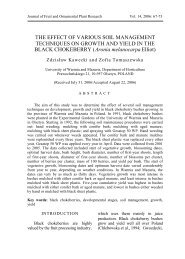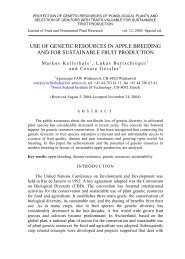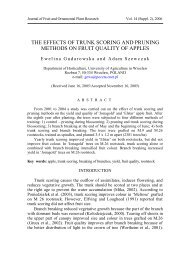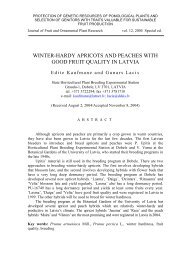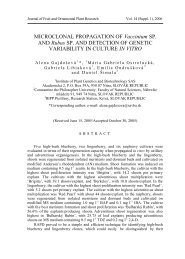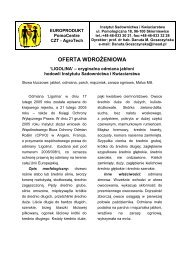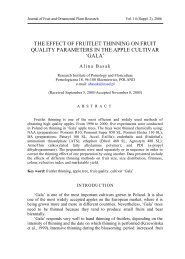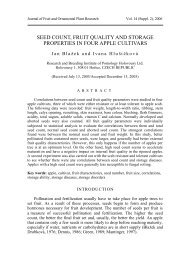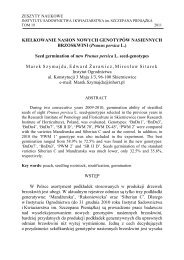Cornelian cherry germplasm resources of Turkey
Cornelian cherry germplasm resources of Turkey
Cornelian cherry germplasm resources of Turkey
You also want an ePaper? Increase the reach of your titles
YUMPU automatically turns print PDFs into web optimized ePapers that Google loves.
<strong>Cornelian</strong> <strong>cherry</strong> <strong>germplasm</strong> <strong>resources</strong> <strong>of</strong> <strong>Turkey</strong><br />
It is not known how the various <strong>Cornelian</strong> <strong>cherry</strong> genotypes in <strong>Turkey</strong> are<br />
related to each other. Genotypes have to be collected from the field and assembled<br />
in suitable locations where they can be systematically evaluated. It would also be<br />
useful to have a centralized location for evaluation, selection, breeding, propagation<br />
and distribution. Efforts are underway to establish a centralized collection at the<br />
Ataturk Central Horticultural Research Institute in Yalova.<br />
The collection and evaluation <strong>of</strong> <strong>Cornelian</strong> <strong>cherry</strong> genotypes should be<br />
given very high priority because many genotypes are in danger <strong>of</strong> being lost.<br />
These genotypes are indispensable for increasing the commercial potential <strong>of</strong><br />
cultivated <strong>Cornelian</strong> <strong>cherry</strong> varieties. The first step in the conservation<br />
process is to identify threatened populations and develop effective strategies<br />
to protect them. The best longterm strategy is to introduce selected productive<br />
genotypes into state and private nurseries and orchards.<br />
Genetic <strong>resources</strong> provide a sustainable source <strong>of</strong> genetic raw material for<br />
improving cultivated varieties. They contain unique naturally selected coadapted<br />
gene constellations which determine adaptability and productivity.<br />
Therefore, the conservation <strong>of</strong> genetic <strong>resources</strong> is <strong>of</strong> paramount importance<br />
for reliable and sustainable food production for future generations.<br />
REFERENCES<br />
Anonymous 2001. Agricultural Structure (Production, Price, Value). State<br />
Institute <strong>of</strong> Statistics Prime Ministry Republic <strong>of</strong> <strong>Turkey</strong>. 600 p.<br />
Baytop T. 1984. Turkiyede Bitkilerle Tedavi. I.U.ECZACILIK FAK. YAY. 40: 298299.<br />
Chamberlain D.F. 1972. Flora <strong>of</strong> <strong>Turkey</strong> and East Aegean Islands. In: P.H.<br />
Davis (ed.). Edinburgh University Press, Edinburgh, pp. 54041.<br />
Chiej R. 1984. Encyclopaedia <strong>of</strong> Medicinal Plants. MacDonald Company, 356 p.<br />
Ercisli S. 2004. A short review <strong>of</strong> the fruit <strong>germplasm</strong> <strong>resources</strong> <strong>of</strong><br />
<strong>Turkey</strong>. GEN. RES. CROP EVOL. 51: 419435.<br />
Eris A. Soylu A. Barut E. Dalkılıç Z. 1992: The selection studies<br />
on cornelian <strong>cherry</strong> cultivars grown in Bursa Region. Proc 1 st Nat. Hort. Con. 20<br />
24 September 1992, pp. 499502.<br />
Karadeniz T. 1995. A study on the selection <strong>of</strong> native cornelian cherries grown<br />
in Gorele district in <strong>Turkey</strong>. BAHCE 24(12): 3644.<br />
Karadeniz T. 2000. Selection <strong>of</strong> native cornelian cherries grown in <strong>Turkey</strong>. J.<br />
AMER. POMOL. SOC. 56(3): 164167.<br />
Karadeniz T. Kalkisim O. Baltaci C. 2001. The investigation on<br />
pomological characteristics <strong>of</strong> cornelian <strong>cherry</strong> (Cornus mas L.) grown in Trabzon.<br />
Proc. 1 st Nat. Stone Fruits Symp., 2528 September 2001, Yalova, pp. 307311.<br />
Kayacik H. 1966. Orman ve park ağaçlarının özel sistematiği, IU ORMAN FAK.<br />
YAY 106/3: 164169.<br />
Pirlak L. Guleryuz M. Bolat I. 2003. Promising cornelian cherries<br />
(Cornus mas L.) from the Northeastern Anatolia region <strong>of</strong> <strong>Turkey</strong>. J. AMER.<br />
POMOL. SOC. 57(1): 1418.<br />
J. Fruit Ornam. Plant Res. Special ed. vol. 12, 2004: 8792 91




